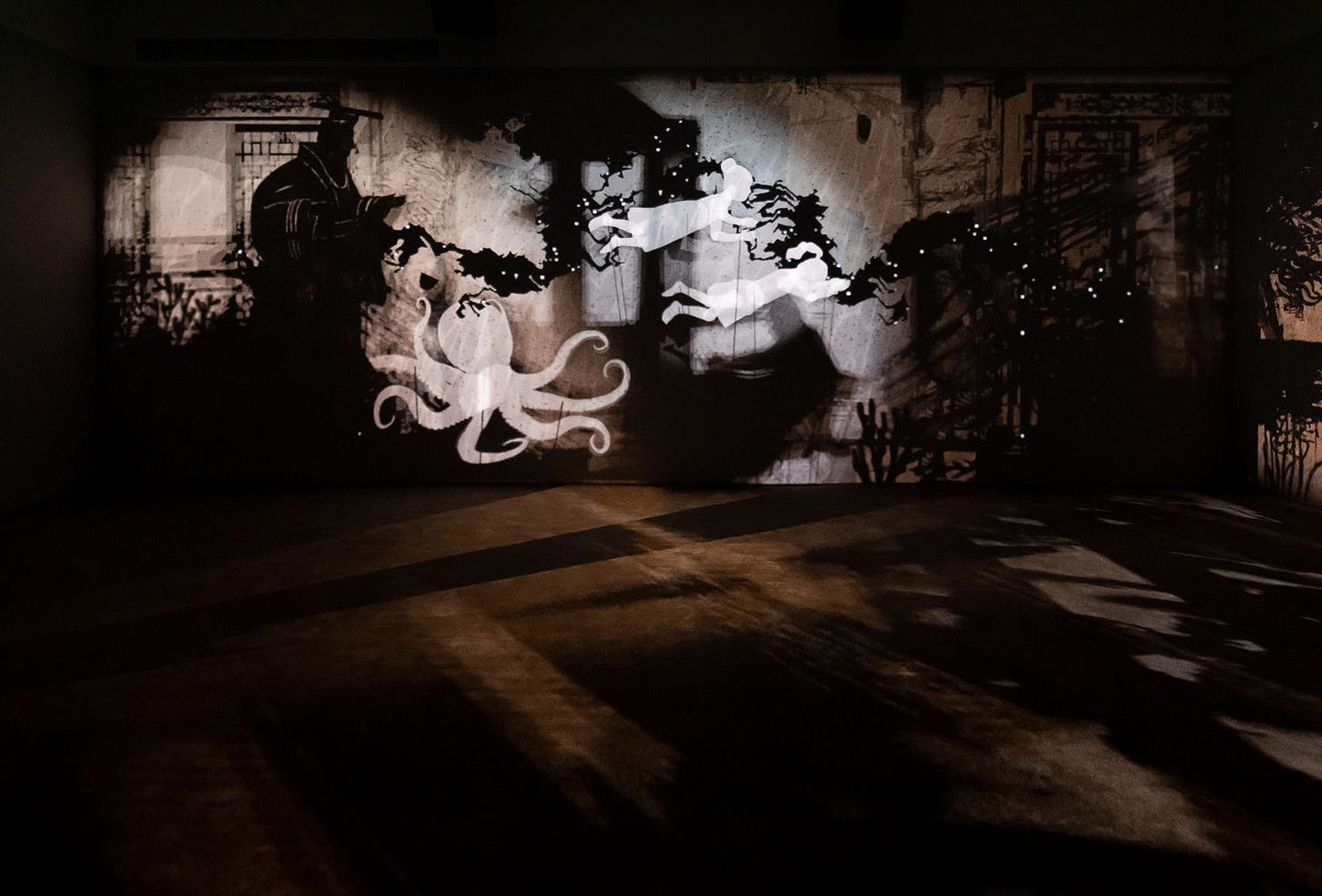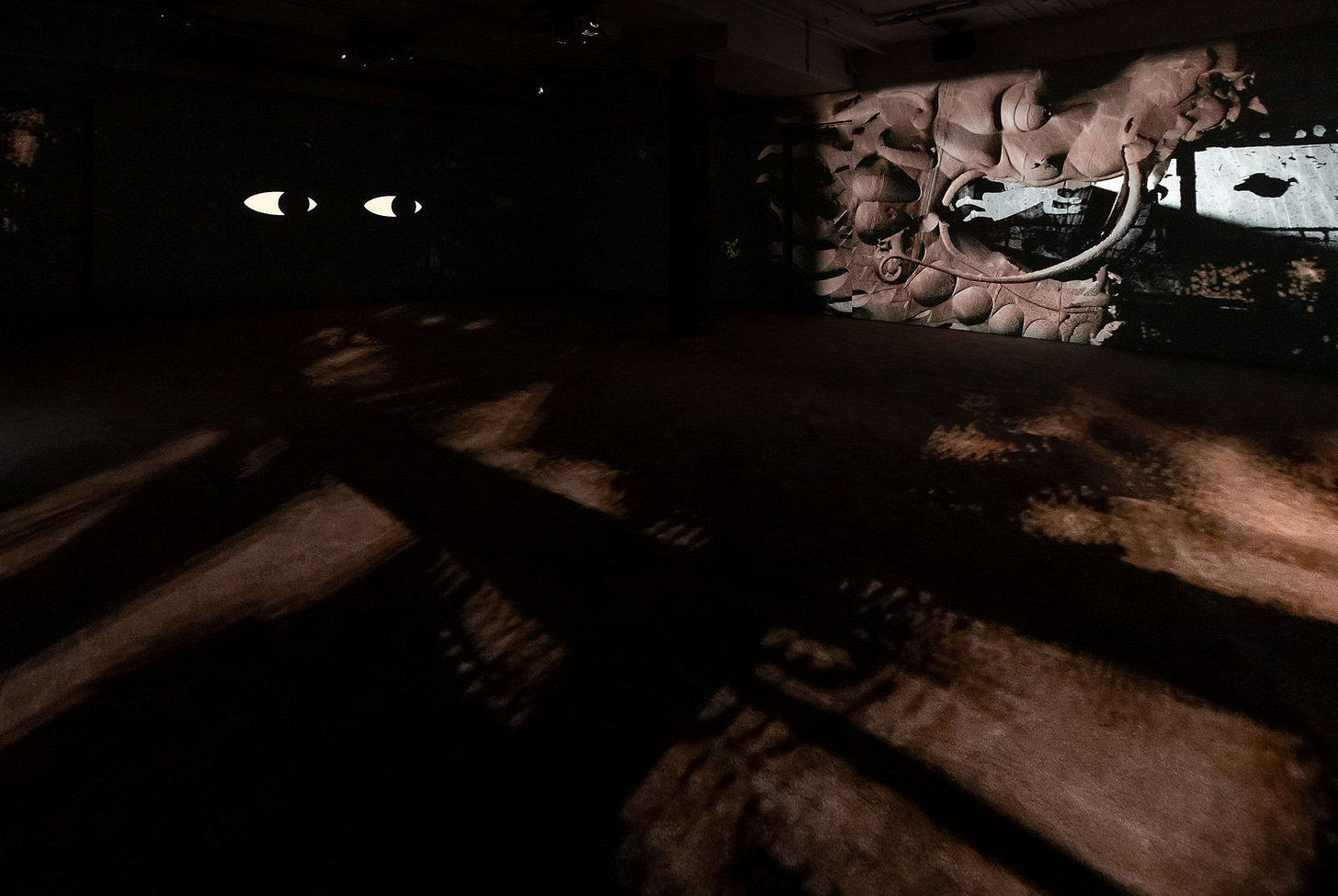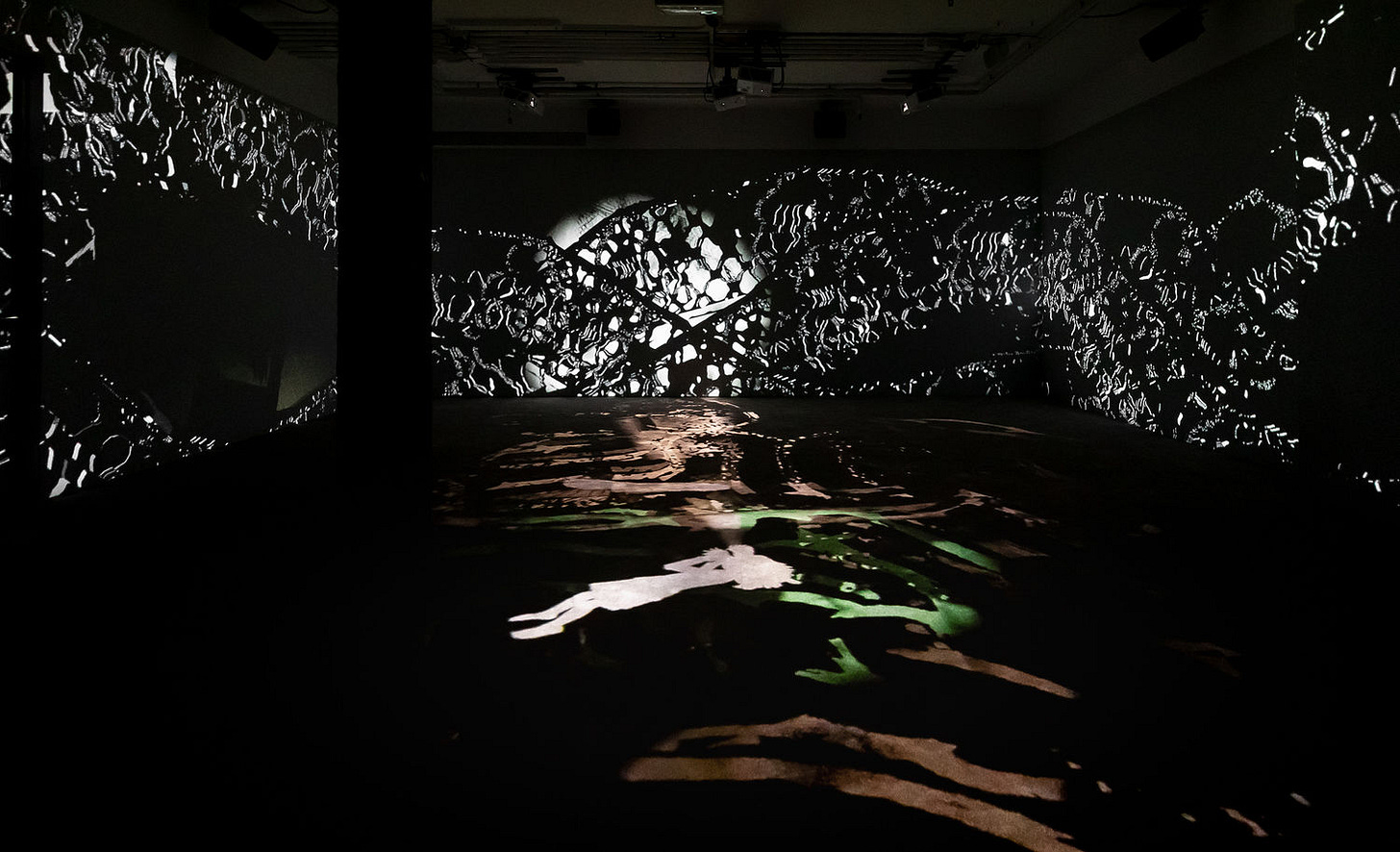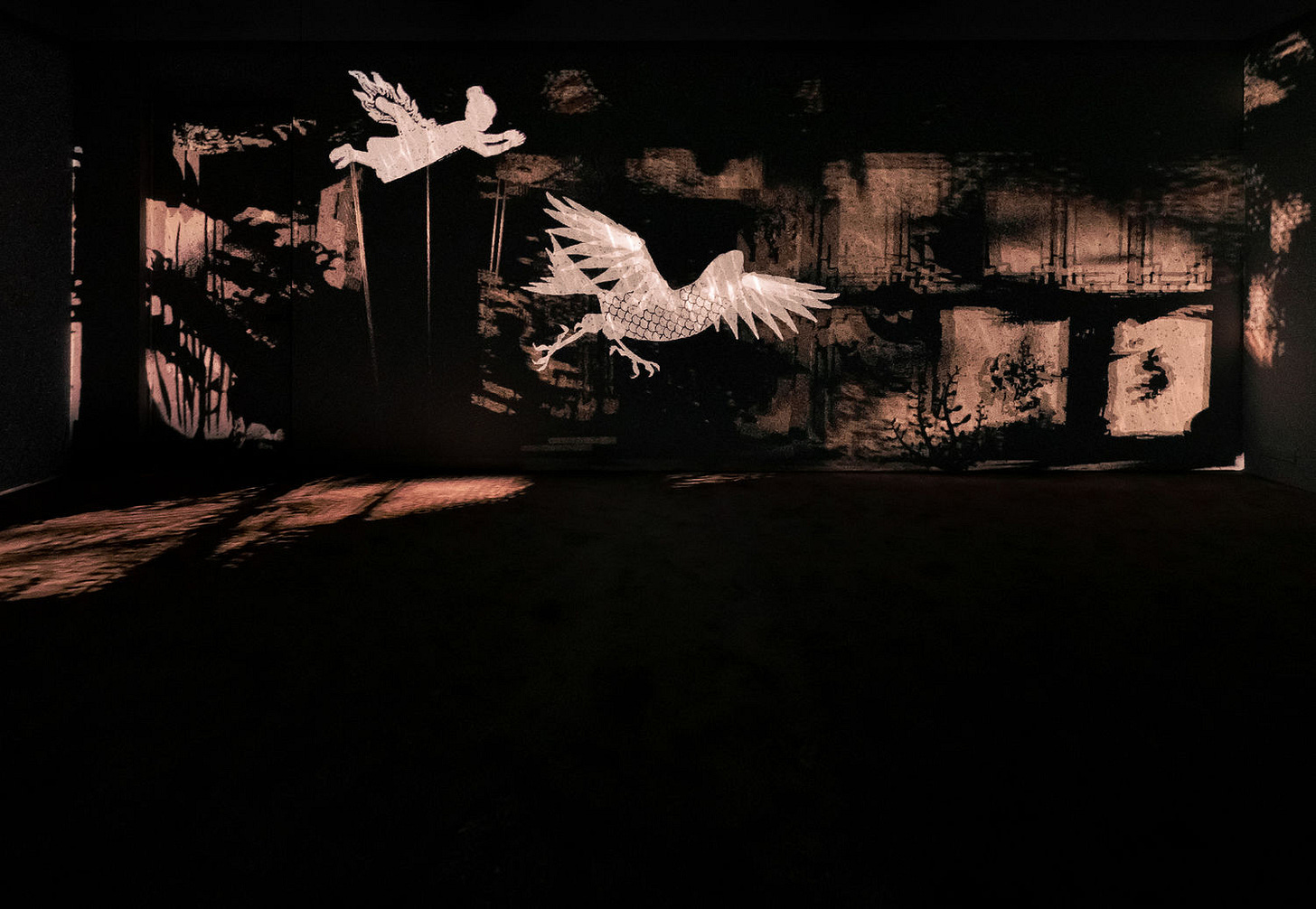
In a small dark room all is still, sitting on a bench at its center, the air hums with anticipation. Then, projections begin to swim across the ceiling and floor, patterns and bits of mythical beasts, layers upon layers of images flow around you, while voices and a watery soundscape bathe the room in sound. Thus begins Tales of the Altersea, a “cosmological media installation” by artist Lap-See Lam, now on view at the Hammer Museum. It is an epic tale of loss, reconnection and regeneration, and at its heart are two twin girls exploring a sunken palace in search of identity. Lam lives and works in Sweden, and is the second generation of her family there, her grandmother having emigrated from Hong Kong in the seventies. Growing up above her grandmother's Chinese restaurant, Lam always felt this “inbetweenness” of cultural identity; Chinese and Swedish and yet neither; working with her heritage and yet performing it as “exotic” for outsiders. She felt connected to a world she had never seen, heard bits of family history or old folklore, but incomplete and wondered what had been lost in the translation across generations. Questions around these issues drive Lam’s work and created Tales of the Altersea, a journey that began with the closing of her grandmother's restaurant and the sight, from her studio, of an abandoned dragon ship.

In the early nineteen nineties a Swedish/Chinese entrepreneur wanted to bring the Hong Kong tradition of grand restaurant boats to the Nordic countries. In pursuit of this he has a three story boat constructed in the Imperial Chinese style, three stories tall with full industrial kitchen and space for two-hundred and thirty diners. The ship sailed from Shanghai to Gothenburg, Sweden, to a dock called the Quay of Dreams (the name of another work by Lam). The restaurant failed financially within a year and the ship was eventually abandoned at a dock, Lap-See Lam could see the mouldering ship from her studio as a student and it struck a chord in her. Later on in the 2000s the ship was cleaned out annually and used by an amusement park as a haunted house filled with “chinese ghosts”. All of this history and cultural symbolism was floating around the artist's head at the same time her family was shutting down and selling her grandmother's Chinese restaurant.
Wanting to document this space that was both central to her biography, and a space of cultural performance for others; she created a full sized 3D scan of the restaurant as it was on the last day of operation. This became part of a larger project by Lam to document the Chinese diaspora in Nordic countries as its first generation was dying out. Alongside her grandmothers, many of the original Chinese restaurants in Sweden were closing in the early 2010’s, Lam’s digital scans became the archive of a fading history. She also began building up a library of 3D scans of other Chinese cultural objects and materials. Yet no matter how diligent her work there were always gaps, glitches, or distortions in the scans that made them imperfect memories. Lam connected this to the cultural loss across time, geography, and generations of the Chinese diaspora writ large. She was filled with a desire to fill these gaps with her own narratives and creations, her addition to a grand narrative, to the generations, and a way of healing. From this desire all of her work has grown and Tales of the Altersea was born.

Within the work, the room is the size and shape of her grandmother's original restaurant and the projections begin and end with digital scans from the Dragon ship. The medium of video installation allowed Lam to marinate the viewer in the ideas, imagery, and symbolism she was working with, without intellectualizing any one part. Lam considers the Chinese restaurant as a magical realist space and weaves a tale to match, saying that making it fantasy distracts her from the deep personal history involved so she can see it clearly. Lam creates the space and images first and the narrative arises from them. The story is told to us by a Lo Ting, a half-human/half-fish mythological figure and ancestor of the Hong Kong people. He tells us how twin sisters Dalia and Julia find a sunken palace that is also a ship at the bottom of the sea. This sea is both their own minds and the cultural ocean they live in, the ship a sign of displacement. Once inside the twins meet a myriad of hybrid and half complete Chinese mythological and historical figures who guide them along the way. They are pursued by a monster known only as The Hunger, who represents cultural alienation and loss. Eventually the girls adopt parts from the mythological beings they meet, discovering their own hybridity, and use them to elude The Hunger and return to the surface, renewed. By embracing aspects of their traditional culture, different for each sister, they not only heal but become more than they were before, something new, that grew from the best of the old and can meet the challenges of the future.

The work weaves together many different threads of Chinese folklore, material culture, and contemporary technology. Each creature or new part of the ship is built up from digital scans Lam took of Chinese fabrics, baskets, statues and jewelry; layered one over the other in order to imitate the levels of history and generational legacy. The famed story of the carp, who dreamed of becoming a dragon and jumped over an enchanted waterfall to transform into one, is referenced throughout the work and becomes the vehicle that returns the girls to the surface at the end.
The dragon is symbolic of China, Chinese culture, and the boat that inspired the whole work; with Asian dragons themselves being hybrids built from parts of many different animals. When working with the digital scan she took of the dragon ship, Lam accidentally deleted the walls and left only the outline, this reminded her of the sets in ancient Chinese shadow plays which ended up inspiring the whole format of the story. By utilizing this ancient art she wanted to create another strand of history, to reach back to older forms of storytelling, and include another legacy of the past, modified across time, and brought into the future. Lam took the failed history of the floating restaurant and crafted it into a mythology that acts as an allegory for webs of family, memory, and cultural legacy. This transformation helped Lam to reconcile differing aspects of her identity and speaks to the experience of peoples living in diaspora. From this work Lap-See Lam went on to represent at the Nordic pavilion in the Venice Bienale in 2024. Using the characters and story created in Tales of the Altersea she crafted a full opera, building generational legacy within her oeuvre.
The twin girls, now transformed by their encounter with the mythological past, rise to the surface on the back of a winged fish dragon, green like spring. They are rejuvenated knowing their past is not a ghost or weight but a fertile ocean from which to grow, adding their own part for the future. Lap-See Lam uses Tales of the Altersea to wrestle with the conflicting aspects of being part of a diaspora and forges her own answer through her gripping work. She says the title refers to alter as in change, a sea that alters you or an ocean of changes. A place where everything from the past is thrown in and we must dive in and swim through it all in order to discover who we truly are.





Chris, you wrote, “ The work weaves together many different threads of Chinese folklore, material culture, and contemporary technology. Each creature or new part of the ship is built up from digital scans Lam took of Chinese fabrics, baskets, statues and jewelry.”
It resonates with a person’s life experiences coming together to make them whole or complete. I like how Lam tells her story through the lens of mythology. Great article - makes me want to see the show NOW. Thank you!